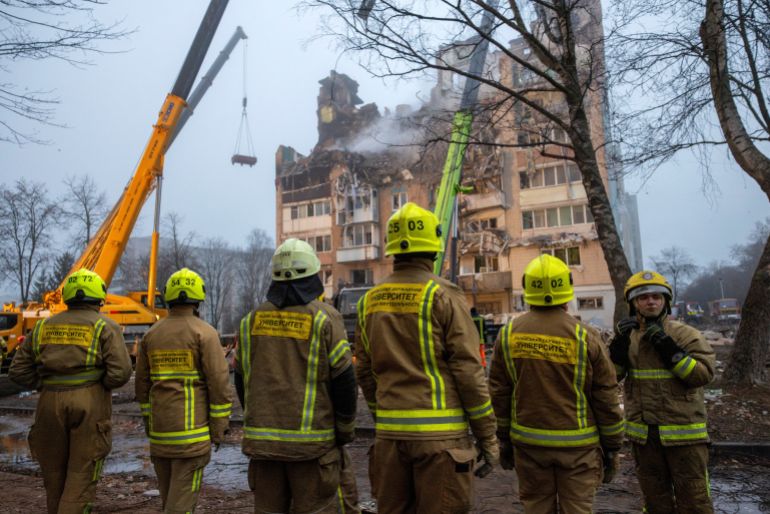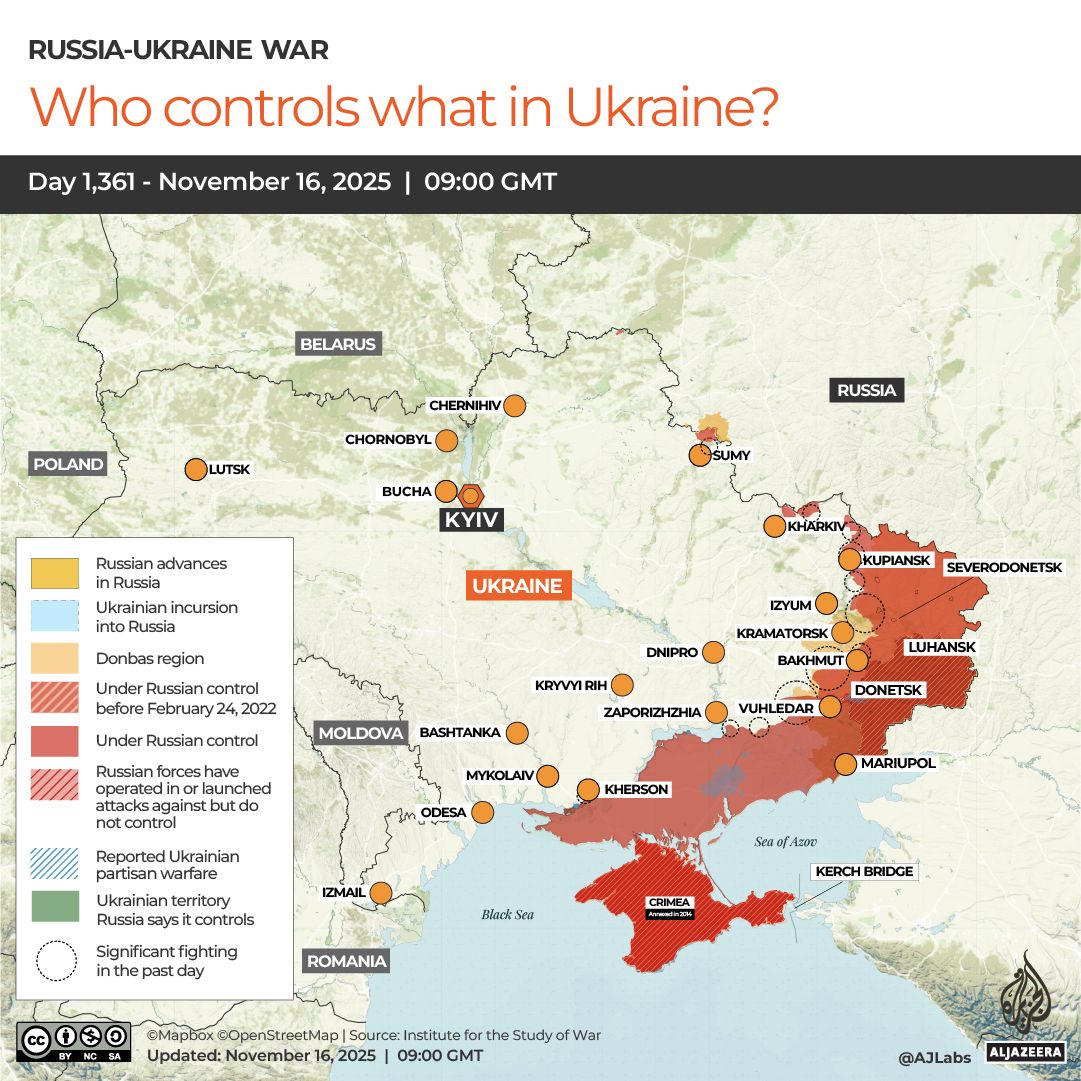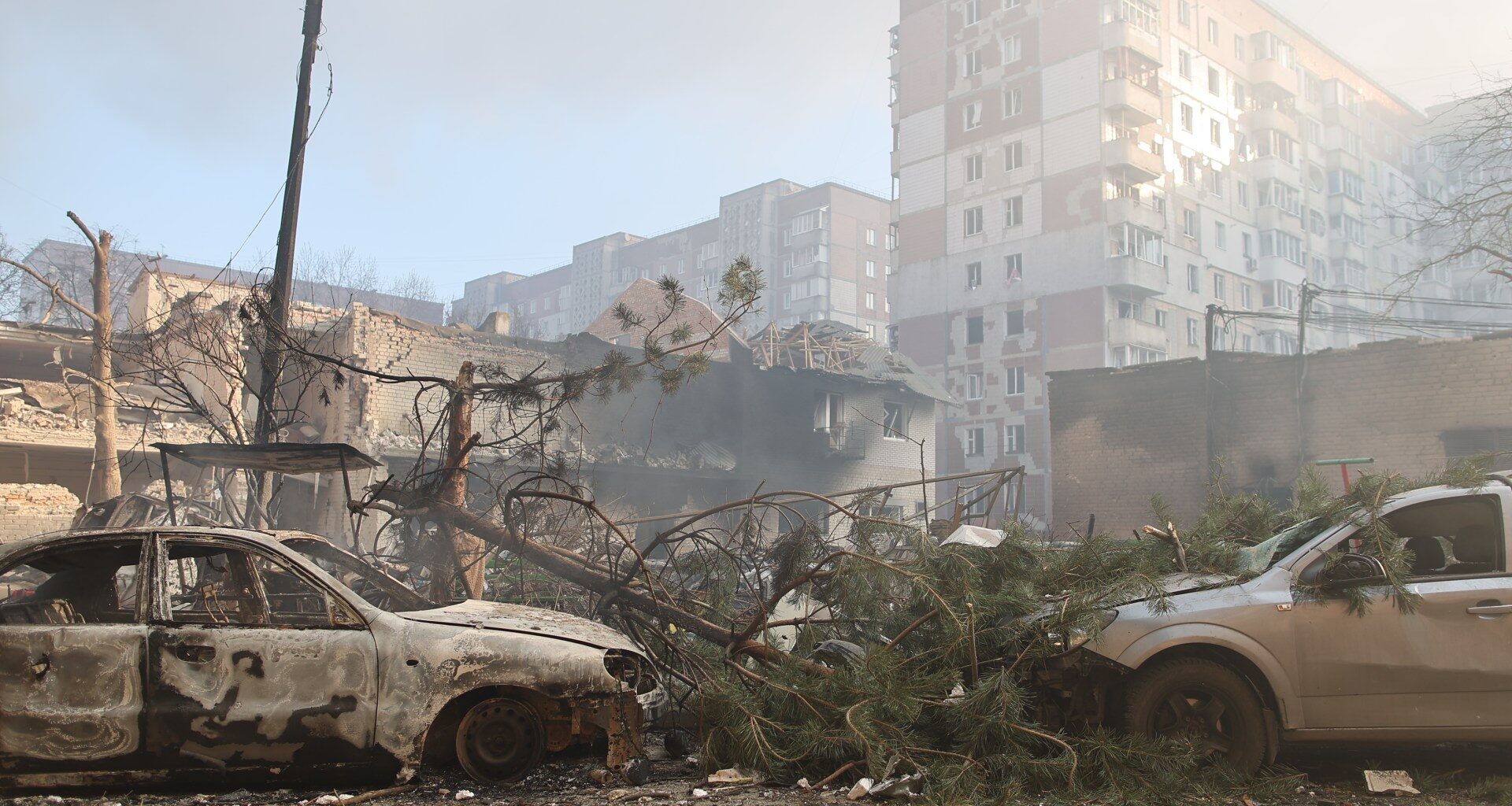The United States and Russia are believed to have drafted a new framework to end the Russia-Ukraine war, according to multiple international news outlets.
Under the plan, which covers 28 points, Kyiv would be required to concede weapons and territory.
Recommended Stories list of 4 itemsend of list
The news comes one day before Ukrainian President Volodymyr Zelenskyy is due to meet US army officials in Kyiv on Thursday.
Here is what we know so far about the plan, and what concessions Kyiv would have to make.
Is this plan an official proposal?
No. The US has not yet officially announced it, and Russia has even denied the existence of such a peace plan.
However, multiple news outlets have reported its existence, citing unnamed sources. US digital news outlet Axios and the United Kingdom’s Financial Times newspaper were the first to report details of the plan on Wednesday.
Reuters later quoted two unnamed sources familiar with the matter, reporting that the US has “signalled” to Zelenskyy that Ukraine must accept the US plan, which involves Ukraine ceding territory and weapons. Other reports have suggested that this would be in exchange for US security guarantees.
The Financial Times quoted an unnamed official saying the proposal is “heavily tilted towards Russia” and “very comfortable for [Russian President Vladimir] Putin”. It does not say where the official is from. The Financial Times also reported claims that only US and Russian officials had participated in drafting the plan.
The newspaper added that the US had informed Ukraine of the plan via Trump’s special envoy to the Middle East, Steve Witkoff, this week.
Citing an unnamed US official with “direct knowledge”, Axios reported that the plan would give Russia parts of eastern Ukraine that Moscow does not currently control, in exchange for a US security guarantee for Ukraine and Europe against future Russian aggression.
However, Keir Giles, a Russian military expert at London think tank Chatham House, said the proposal may not originate from the US at all. He described the way news of the plan had emerged as a “Russian information operation rather than the basis of reality, which Western media has willingly bought into yet again” in an interview with Al Jazeera.
In a response to a post on X with the link to the Axios story, Witkoff said on Wednesday: “He must have got this from K.” He did not explicitly confirm or deny the existence of the 28-point plan.
The post, which Witkoff may have “thought was a direct message” to someone else, Giles said, has since been deleted.
Giles said that “K” could refer either to Putin ally and head of the Russian Direct Investment Fund (RDIF), Kirill Dmitriev; or Keith Kellogg, Trump’s special envoy for the Russia-Ukraine war.
The Financial Times report names Dmitriev as one of the “architects” of the new proposal.
 Students preparing to be firefighters gather in front of an apartment building that was hit on Wednesday by a Russian missile in Ternopil, Ukraine, November 20, 2025 [Thomas Peter/Reuters]What have US and Ukrainian officials said?
Students preparing to be firefighters gather in front of an apartment building that was hit on Wednesday by a Russian missile in Ternopil, Ukraine, November 20, 2025 [Thomas Peter/Reuters]What have US and Ukrainian officials said?
The White House has declined to comment on the matter.
US Secretary of State Marco Rubio wrote on X that the US “will continue to develop a list of potential ideas for ending this war based on input from both sides of this conflict”.
Rubio added: “Ending a complex and deadly war such as the one in Ukraine requires an extensive exchange of serious and realistic ideas. And achieving a durable peace will require both sides to agree to difficult but necessary concessions.”
Zelenskyy, who was holding talks in Turkiye with President Recep Tayyip Erdogan on Wednesday, has also not commented on the alleged proposal.
“The main thing for stopping the bloodshed and achieving lasting peace is that we work in coordination with all our partners and that American leadership remains effective, strong,” Zelenskyy wrote on Telegram after his meeting with Erdogan in Ankara.
Zelenskyy said that only the US and Trump “have sufficient strength for the war to finally come to an end”.
What has been reported about the terms of the plan?
According to Axios, the plan spans 28 specific but unknown points. Overall, it would give Russia full control over both Crimea in the south – which Russia seized from Ukraine in 2014 but which remains in dispute – and the Donbas region, which is made up of Donetsk and Luhansk in eastern Ukraine.
In Donbas, Russia currently controls all of Luhansk and most of Donetsk. According to the Institute for the Study of War, overall, Ukraine still controls 14.5 percent of the territory in the Donbas region including parts of Donetsk around the cities of Sloviansk and Kramatorsk.
Ukraine would be required to withdraw its troops from the Donbas altogether, and it would become a demilitarised zone, with Russia also unable to place its troops there.
Axios quoted an unnamed Ukrainian official saying the plan also imposes longer-term limits on the size of Ukraine’s military and its possession of long‑range missiles.
In addition to Crimea and the majority of the Donbas region, Russia also now controls 75 percent of Zaporizhia and Kherson in southern Ukraine, bordering the Black Sea. According to the plan, the existing battle lines in these two areas would be frozen in place. The return of any of this territory to Ukraine would be subject to later negotiations.
Would this plan be good for Ukraine?
Analysts said, on face value, this plan does not favour Ukraine at all. “If the plan, as has been suggested to media were implemented, this would leave Ukraine defenceless against the next Russian attack,” Giles said.
He added that a reduction in the size of its army and limitations on its long-range weapons would leave Ukraine too vulnerable. He described the plan as “catastrophic to European security”.
“It seems that Ukrainian armed forces will have to be reduced by 2.5 times [reduced by 60 percent] of its size – that means Ukraine cannot have more than 400,000 personnel,” Marina Miron, a postdoctoral researcher at the defence studies department at King’s College London, told Al Jazeera, based on what she has read about the plan. “It also says Ukraine shouldn’t have any long-range capabilities that would be able to strike Russia. Then the territories under Russian control would be officially recognised as well as Crimea.”
“This plan seems to obviously favour Russia, and it is interesting to see whether the United States can exert enough leverage on Ukraine and on Zelenskyy to accept this plan,” Miron said.
 (Al Jazeera)
(Al Jazeera) (Al Jazeera)How has Trump’s position changed over time?
(Al Jazeera)How has Trump’s position changed over time?
Trump has flip-flopped on the issue of Ukraine ceding land to Russia several times this year.
Late last month, Trump suggested freezing the war in Ukraine at its current battle lines.
“You leave it the way it is right now. They can … negotiate something later on down the line,” Trump told reporters on Air Force One in October. This plan was rejected by Russia, which has made clear it is determined to achieve its war goal of the withdrawal of Ukraine’s military from the eastern regions that Moscow lays claim to.
Ukraine and its European allies supported this plan at the time. “The current line of contact should be the starting point of negotiations,” they said in a joint statement. This marked a shift for Ukraine, which had previously insisted on reclaiming all of its land.
It was also a change in stance by Trump, who on September 23, said Ukraine could win back all its territory captured by Russia since the beginning of the war with help from the European Union and NATO.
“With time, patience, and the financial support of Europe and, in particular, NATO, the original Borders from where this War started, is very much an option,” Trump wrote on his Truth Social platform back then.
Before that, on August 11, Trump said both Russia and Ukraine would have to cede territory to end the war. He told reporters that Russia had taken some of Ukraine’s “very prime territory” and “we’re going to try to get some of that territory back”. At this point, Zelenskyy rejected the idea of conceding any land.
In February this year, Trump met with Zelenskyy in the Oval Office. Trump and his vice president, JD Vance, berated Zelenskyy during this meeting for not being “grateful” enough for American support in the war so far.
Trump indicated that ending the war would require Ukraine to give up some territory, telling Zelenskyy: “You should be grateful. You’re not in a strong position – you’re trapped there, your people are dying, and you’re running out of soldiers.”
On the campaign trail ahead of the US election last year, Trump promised to end the Ukraine war in the first 24 hours of his presidency. Trump was inaugurated in late January this year, and about 11 months later, all his attempts at peace talks have been unsuccessful.
The war in Ukraine has been dragging on since February 2022. On Wednesday, a Russian aerial attack on Ternopil in western Ukraine killed at least 26 people and injured several others, according to Ukrainian Interior Minister Ihor Klymenko.
What will happen next?
Miron said she believes that if this plan is presented, Ukraine and Europe will reject it due to its heavy favouring of Russia.
“We will get into another cycle of rewriting the plan, and Ukraine and Europe will have their own demands. Allegedly, Zelenskyy had a plan of his own in Turkiye which was put together with his European allies,” Miron said.
If the reports about the plan are true, the plan will likely set off a “diplomatic game”, she added.
“If Ukrainians and Europeans reject the plan, then Trump can always say, ‘Well, we came with a plan to you and you rejected it. And so you are in the way to achieve a lasting peace’.”
Miron added: “The Europeans plus Ukraine and the Russians have been playing this game, each of them kind of presenting something that they know the other side will reject. So then the ball will be in Europe’s and Ukraine’s court.”
